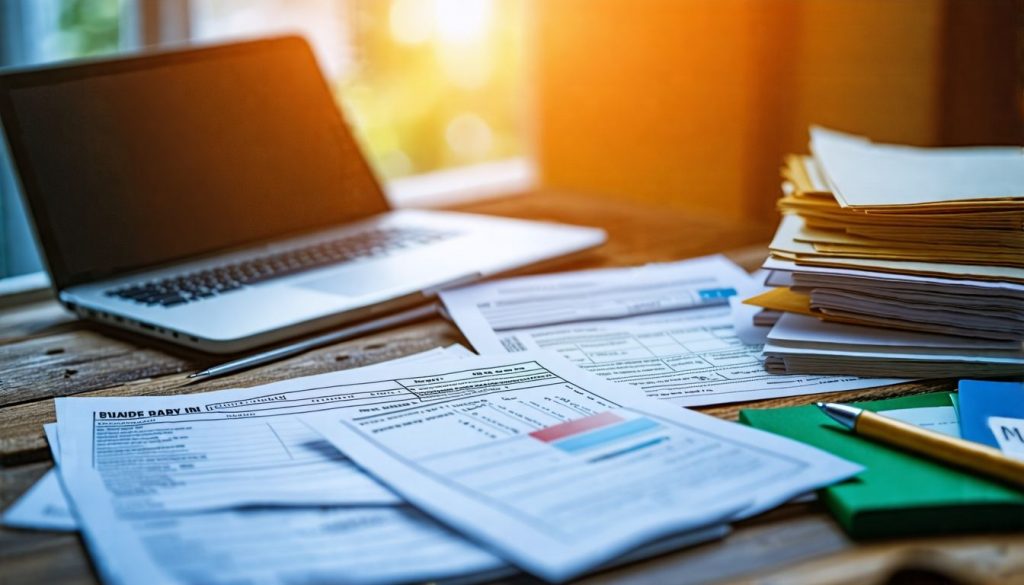Struggling with high-interest debts from multiple credit cards is a common challenge. A staggering number of people are looking for effective ways to manage and reduce their financial burdens.
This guide on how to consolidate credit card debt offers practical strategies and solutions, aiming to simplify your payments and possibly lower your interest rates. Keep reading for a clear path out of the debt maze.
Key Takeaways
- Debt consolidation combines all your debts into one payment, which can lower interest rates and make monthly payments easier to manage.
- Options for consolidating debt include personal loans, lines of credit, home equity loans, balance transfer cards, and working with credit counseling services.
- It’s important to prioritize paying off high-interest debts first and use strategies like the debt snowball method or seeking professional advice to effectively reduce what you owe.
- Avoid scams by thoroughly researching companies offering debt consolidation services and be wary of promises that seem too good to be true.
- Closing accounts you’ve paid off can improve your credit score, but it’s essential to consider how this affects your overall credit health before making a decision.
Understanding Debt Consolidation
Debt consolidation simplifies your financial situation by combining multiple debts into one. It can help reduce interest rates and make payments easier to manage.
What is debt consolidation?
Debt consolidation combines multiple debts into a single loan, making payments more manageable. This strategy can improve cash flow and potentially lower interest rates across the board.
Canadians often use this approach to simplify their debt repayment process, which may include credit card consolidation or personal loans.
Several options exist for consolidating debt, such as personal loans from banks or credit unions. These financial products aim to reduce monthly payments and streamline budgeting efforts.
Engaging in a debt management plan can be an effective way to organize finances while working towards becoming debt-free.
Methods of debt consolidation
Debt consolidation helps combine multiple debts into a single payment. Canadians have various methods to choose from for managing this process effectively.
- Personal Loans
An unsecured personal loan allows you to borrow a set amount from a bank or credit union. Use the funds to pay off high-interest credit card balances, leaving you with just one monthly payment and usually a lower interest rate.
- Lines of Credit
A line of credit offers flexibility in borrowing money up to a specified limit. You can use it to pay off existing debts, benefiting from potentially lower interest rates compared to credit cards. Interest only applies to the amount borrowed.
- Home Equity Loans
A home equity loan uses your home’s value as collateral for borrowing money. This option often features lower interest rates since it is secured by your property, making it easier to manage payments while paying off credit card debts.
- Credit Counseling Services
Working with a reputable credit counseling agency can guide you through debt consolidation options tailored to your financial situation. These professionals help create a personalized debt consolidation plan, guiding you in managing debts effectively.
- Debt Management Plans (DMP)
DMPs involve negotiating with creditors on your behalf for better payment terms and lower interest rates. You’ll make one monthly payment, which the credit counseling agency distributes among your creditors, simplifying the repayment process.
- Balance Transfer Cards
A balance transfer card allows you to move existing debt onto a new card with 0% introductory APR for a set period. This strategy reduces or eliminates interest charges temporarily, giving you time to pay down the debt without accruing more fees.
- Credit Unions and Community Banks
Smaller financial institutions may offer competitive loan products specifically designed for consolidating debt. They often provide personalized service and flexible terms not always available at larger banks.
- Secured Credit Cards
A secured credit card requires cash collateral equal to your spending limit, reducing lender risk and allowing rebuilding of your credit score while managing debt responsibly.
- Cosigner Options
If qualifying for loans is challenging due to poor credit history, having a cosigner can improve approval chances and secure better interest rates on loans or lines of credit used for debt consolidation.
- Debt Consolidation Programs
Participating in formal programs offered by some non-profits can consolidate multiple debts into fewer payments under specific terms which help simplify your financial obligations while working towards becoming debt-free efficiently.
These methods provide various approaches that can significantly aid in improving cash flow and managing outstanding balances wisely within Canada’s financial context.
Avoiding debt consolidation scams
Avoiding debt consolidation scams requires vigilance and awareness. Research any company offering a debt consolidation program thoroughly. Look for reviews from other Canadians who have used their services.
Trustworthy companies will provide clear information about their fees and terms without pressure to sign immediately.
Be cautious of lenders promising quick fixes or that seem too good to be true. Fraudulent schemes often ask for upfront payments or personal information before providing assistance.
Protect your financial future by staying informed about legitimate debt repayment options, such as credit counseling or reputable debt consolidation loans available through banks and credit unions.
Understanding these methods can guide you toward effective solutions for managing your credit card debts effectively.
Consolidation Solutions from Banks
Banks offer various solutions for consolidating debt. Personal loans, lines of credit, and home equity loans can help simplify your payments and lower interest rates.
Personal loans
Personal loans serve as a practical option for consolidating credit card debt. They allow borrowers to combine multiple debts into a single loan with often lower interest rates compared to credit cards.
Many Canadians opt for personal loans since they can simplify monthly payments and help individuals pay off their debts more efficiently.
Lenders typically offer fixed repayment terms, making it easier to manage finances. These loans can range from several thousand to tens of thousands of dollars, depending on the lender’s policies and the borrower’s creditworthiness.
Secured credit cards may also be useful when utilizing these funds responsibly after consolidating debt.
Lines of credit
Lines of credit are a flexible option for consolidating credit card debt. Canadians can tap into this financial product to borrow against a pre-approved limit. This means you only pay interest on the amount you use, which can be significantly lower than typical credit card rates.
Many Canadians find this approach beneficial, especially if they have multiple debts with varying interest rates.
A line of credit often has better terms compared to traditional loans, including lower monthly payments and flexible repayment options. Using a line of credit responsibly can help streamline your finances as you work towards paying off debts more effectively.
Understanding these options paves the way for exploring home equity loans, another viable solution in the debt consolidation process.
Home equity loans
Home equity loans allow homeowners to borrow against the equity they’ve built in their property. This type of loan typically offers lower interest rates compared to credit cards, making it an attractive option for consolidating credit card debt.
Canadians can access significant funds based on their home’s appraised value, minus any existing mortgage balance.
These loans provide a fixed amount paid back over a set term, which simplifies repayment planning. Utilizing home equity for debt consolidation can lead to substantial savings by combining higher-interest debts into one manageable payment with a lower rate.
Always consider the risks involved, such as potential loss of your home if payments are missed.
Strategies for Paying Off Debt
Establish a plan to tackle your high-interest debts first. Focus on paying off smaller balances for quick wins. Talk to family and friends who may help with managing your debts. Engage with financial institutions and creditors to find workable solutions that suit your needs.
Discover more about effective debt payment strategies in the full guide!
Prioritizing higher interest debts
High-interest debts can quickly become overwhelming. Tackling these debts first can save you money in the long run and help improve your financial planning.
- Identify high-interest debts: Begin by listing all your credit cards and loans along with their interest rates. This step highlights which accounts are costing you the most money.
- Focus on credit cards: Credit card debt typically has higher interest rates than personal loans or lines of credit. Concentrate on paying off these balances first since they can accumulate rapidly if left unchecked.
- Make more than minimum payments: Paying only the minimum amount extends the life of your debt due to accruing interest. Aim to pay significantly more when possible, especially on high-interest balances, to reduce what you owe faster.
- Consider debt snowball method: This strategy involves paying off the smallest debts first while making minimum payments on larger ones. As each smaller balance is cleared, redirect those funds to tackle higher interest debts more aggressively.
- Utilize windfalls wisely: Any extra cash flow, such as bonuses or tax refunds, should go directly toward your highest-interest debts. This approach boosts your efforts and accelerates repayment.
- Consult a financial advisor: A professional can recommend tailored debt consolidation strategies that may include prioritizing high-interest debts effectively within your overall personal finance plan.
- Set clear goals: Establish specific targets for paying down high-interest debt within a set timeframe. Tracking progress helps maintain motivation and accountability in managing multiple debts effectively.
- Remain disciplined: Make it a habit to stick to your repayment plan without accruing additional debt from other sources during this period, especially from new credit cards or loans that could add pressure to your finances.
Considering lowest balance debts
Focusing on debts with the lowest balances can bring a sense of accomplishment. Paying off these debts quickly may also improve your credit score.
- Clear Smaller Debts First
Start with the debts that have the smallest amounts due. Eliminating these balances gives you quick wins and motivation to tackle larger debts.
- Use Extra Funds Wisely
Direct any extra money you have towards paying off these lower-balance debts. This strategy allows you to reduce your total number of accounts more swiftly.
- Stay Organized
List all your debts from smallest to largest balance. Keeping track helps ensure that no debt goes unnoticed, making it easier to manage payments.
- Celebrate Each Paid Off Debt
Every time you pay off a smaller balance, celebrate that win! Acknowledging these accomplishments keeps you motivated on your journey to consolidate credit card debt.
- Involve Family or Friends
Discuss your plan with trusted family members or friends who can support you financially if needed. Their involvement could provide assistance when you’re trying to consolidate credit card debt effectively.
- Limit New Purchases on Credit Cards
Avoid adding new charges on cards while paying down existing balances. This practice helps prevent further complications in managing multiple debts and makes consolidation easier.
- Review Your Budget Regularly
Adjust your budget as you pay off each small balance. Ensure that the funds previously allocated for those debts are redirected toward other financial goals or remaining obligations.
- Seek Professional Advice if Necessary
If you’re struggling, consult a financial advisor for guidance tailored to your situation involving lower-balance debts and overall strategies for consolidating credit card debt efficiently.
Managing debts with family and friends
Managing debts with family and friends can be a practical solution for Canadians looking to consolidate credit card debt. Open communication is essential. Discuss your financial situation honestly, and explore options like borrowing from them or creating a repayment plan that works for both parties.
This approach often involves smaller interest rates compared to traditional lenders.
Establish clear terms to avoid misunderstandings in the future. Written agreements can help ensure accountability and protect relationships. Paying off multiple debts through this method allows you to reduce stress while maintaining close ties with loved ones.
Combining debt in this way fosters support and understanding during challenging times.
Working with financial institutions and creditors
Building a strong relationship with financial institutions and creditors can significantly ease your credit card debt journey. Open communication and transparency are essential for finding effective solutions.
- Contact Your Creditors Directly
Reach out to your creditors as soon as you realize you may face difficulties. They may offer lower interest rates, modified payment plans, or even temporary relief programs tailored to your situation.
- Ask About Hardship Programs
Some financial institutions provide hardship programs for those in financial trouble. These programs can include reduced payments or a freeze on interest rates to help you regain control over your finances.
- Negotiate Payment Plans
Talk to your bank about creating a manageable payment plan. They might allow you to pay less each month or extend the repayment period, making it easier to meet obligations without additional stress.
- Consider Balance Transfers
Transferring high-interest balances to a credit card with a lower rate could save money on interest payments. Many Canadian credit cards offer promotional 0% APR periods for balance transfers, which can help reduce your overall debt load if managed wisely.
- Seek Professional Advice
Financial advisors can provide guidance on dealing with creditors effectively. They understand various consolidation options and can help develop a personalized strategy based on your individual needs.
- Stay Informed About Your Rights
Knowing your rights regarding debt collection is crucial in Canada. Familiarize yourself with consumer protection laws that prevent unfair practices by creditors and ensure you’re treated fairly during negotiations.
- Utilize Financial Tools Offered by Institutions
Many banks offer financial management tools that help track spending and manage budgets effectively. Taking advantage of these resources can provide insights into improving financial habits while consolidating credit card debt.
Proceeding with clear strategies will enhance how you manage ongoing debt issues effectively through powerful tips on managing debt.
Useful Tips for Managing Debt
Managing debt requires careful planning and smart decisions. Consider closing accounts that you’ve paid off; this action can help improve your credit score.
Closing paid off accounts
Closing paid-off accounts can be a smart move in managing your credit score. This action removes the temptation to rack up additional debt on cards you no longer need. However, it’s crucial to understand how this affects your credit utilization ratio and overall credit history.
A closed account may decrease available credit, which could impact your score negatively if not managed properly.
Maintaining a diverse mix of active accounts often helps keep your score healthy. If you’ve consolidated debt successfully, reevaluating which accounts to close is essential. Focus on keeping older accounts open since length of credit history positively impacts scores.
Closing paid-off accounts should align with your long-term financial strategy as you work toward becoming debt-free through tactics outlined in “The Ultimate Guide: How to Consolidate Credit Card Debt.
Using secured credit cards
Secured credit cards offer a practical solution for Canadians looking to improve their credit score while managing debt. These cards require you to deposit funds as collateral, which typically becomes your credit limit.
This arrangement makes secured cards less risky for lenders, allowing individuals with poor or no credit history to access credit.
Using a secured card can help establish responsible spending habits. Making on-time payments positively impacts your credit report and may lead to eligibility for unsecured cards in the future.
This gradual approach aids in rebuilding financial stability without falling deeper into debt.
Consolidating debts through loans
Consolidating debts through loans can simplify your financial life. This method involves combining multiple debts into a single loan, often at a lower interest rate. Personal loans are common for this purpose and allow you to pay off credit card balances more efficiently.
Lines of credit can also serve as a consolidation tool, offering flexible repayment options.
Home equity loans provide another avenue for debt consolidation by tapping into the value of your home. It’s essential to assess all available options before committing to one solution.
Understanding each option’s terms will help ensure you choose the best path forward in managing your debt effectively. Next, we will explore strategies for paying off your accumulated debt efficiently.
Conclusion
Successfully managing credit card debt can lead to financial freedom. This guide provides essential strategies and solutions for Canadians seeking relief from high-interest burdens.
Utilize the methods outlined here, and take control of your financial future. Remember, informed decisions today can pave the way for a more secure tomorrow. Start your journey toward debt consolidation now!
FAQs
Apologies for the confusion, but there are no keywords provided for Article 2. Please provide the relevant keywords to proceed with creating FAQs on “The Ultimate Guide: How to Consolidate Credit Card Debt”.









